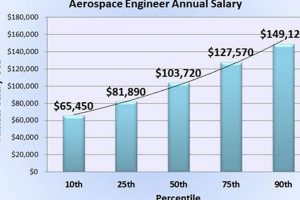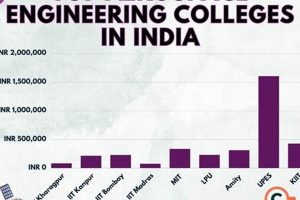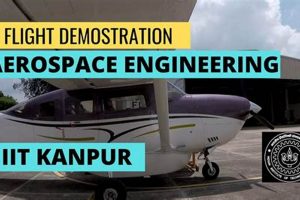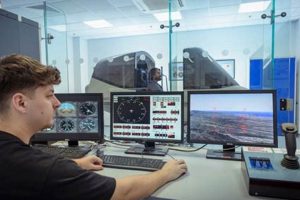The path to a career focused on designing, developing, and testing aircraft and spacecraft within a military setting involves a combination of academic achievement, dedicated service, and specialized training. This career trajectory typically necessitates a strong foundation in mathematics, physics, and engineering principles, coupled with a commitment to upholding the standards and values of the military institution. For example, individuals interested in this field might pursue a bachelor’s degree in aerospace engineering, mechanical engineering, or a related discipline before seeking commissioning as an officer in a relevant branch of the armed forces.
Serving in such a capacity offers unique opportunities for professional growth and contribution to national security. Individuals gain experience working on cutting-edge technologies, leading teams, and managing complex projects with significant impact. Historically, individuals in this field have been instrumental in advancements in aviation, space exploration, and defense systems, contributing to technological superiority and strategic advantages.
The following sections will detail the educational requirements, military commissioning options, specialized training programs, and potential career paths available to individuals pursuing this highly specialized and rewarding profession.
Essential Guidance
The following recommendations are designed to assist those seeking a career in aerospace engineering with a specific focus on military service. Adhering to these guidelines can increase the likelihood of success in this competitive field.
Tip 1: Prioritize STEM Education: A strong background in science, technology, engineering, and mathematics is fundamental. Coursework should include calculus, differential equations, linear algebra, physics, and chemistry. Achieving high grades in these subjects demonstrates academic aptitude and prepares individuals for the rigors of engineering studies.
Tip 2: Pursue an ABET-Accredited Engineering Degree: Enrollment in an aerospace engineering or a closely related engineering program accredited by ABET (Accreditation Board for Engineering and Technology) is crucial. ABET accreditation ensures the program meets established quality standards and prepares graduates for professional practice.
Tip 3: Explore Military Academy Options: Consider attending a military academy. These institutions offer a structured academic environment, leadership training, and a direct path to military service. Graduates receive a commission as officers and are often eligible for specialized training in aerospace engineering.
Tip 4: Research ROTC Programs: Reserve Officer Training Corps (ROTC) programs at universities provide an alternative route to military service. Students can pursue an engineering degree while participating in ROTC training. Upon graduation, they receive a commission as officers.
Tip 5: Gain Relevant Experience: Seek internships or research opportunities in aerospace engineering or related fields. These experiences provide practical skills and demonstrate a commitment to the profession. Working on real-world projects enhances understanding of engineering principles and practices.
Tip 6: Develop Leadership Skills: Military service requires strong leadership skills. Participate in extracurricular activities, such as clubs, sports, or volunteer organizations, to develop leadership abilities. Seek opportunities to lead teams and manage projects.
Tip 7: Maintain Physical Fitness: Meeting the physical fitness standards is essential for military service. Engage in regular exercise and maintain a healthy lifestyle. Prepare for physical fitness assessments required for military commissioning.
These tips provide a roadmap for individuals aspiring to contribute to aerospace engineering within a military context. A combination of academic excellence, practical experience, and leadership development is vital for success.
Following these guidelines represents a crucial step toward achieving the desired career goals.
1. Education
A robust educational foundation is the cornerstone of a successful career integrating aerospace engineering with Air Force service. The complexity and technical demands of this field necessitate a thorough understanding of engineering principles, scientific methodologies, and mathematical concepts. This educational grounding provides individuals with the analytical and problem-solving skills essential for addressing the challenges inherent in the design, development, and maintenance of aerospace systems.
- ABET-Accredited Bachelor’s Degree
A bachelor’s degree in aerospace engineering, or a closely related field such as mechanical or electrical engineering, from an ABET-accredited institution is paramount. ABET accreditation signifies that the program meets rigorous standards for quality and relevance to the engineering profession. This ensures graduates possess the core competencies expected of entry-level aerospace engineers. For example, graduates of ABET-accredited programs are well-versed in areas such as aerodynamics, propulsion, structures, and control systems, enabling them to contribute effectively to aerospace projects.
- Advanced Coursework
Beyond core engineering principles, specialized coursework relevant to Air Force applications is highly beneficial. This may include studies in aircraft design, space vehicle design, hypersonic aerodynamics, or advanced propulsion systems. Such specialized knowledge enhances an individual’s ability to address the specific technological challenges encountered within the Air Force. For instance, understanding hypersonic aerodynamics is crucial for engineers involved in the development of advanced missile systems or high-speed reconnaissance aircraft.
- Research Experience
Engagement in research activities during undergraduate or graduate studies provides invaluable practical experience and fosters critical thinking skills. Participation in research projects related to aerospace engineering allows individuals to apply theoretical knowledge to real-world problems, develop experimental techniques, and contribute to the advancement of scientific knowledge. For example, working on a research project focused on improving the fuel efficiency of jet engines can provide hands-on experience in computational fluid dynamics and experimental testing.
- Relevant Minor/Concentration
Complementing the primary engineering degree with a minor or concentration in a related field can broaden an individual’s skill set and enhance their competitiveness. A minor in mathematics, computer science, or physics can provide valuable tools for tackling complex engineering problems. For example, a minor in computer science can equip engineers with the programming skills necessary for developing software for flight control systems or analyzing large datasets from flight tests.
These facets of education ABET accreditation, advanced coursework, research experience, and complementary skills are inextricably linked to a career in aerospace engineering within the Air Force. This comprehensive educational foundation provides the necessary skills and knowledge to excel in a challenging and rewarding profession, contributing to national security and technological advancement.
2. Commissioning
Commissioning serves as the pivotal gateway to a military career as an aerospace engineer within the Air Force. It is the formal process through which qualified individuals are appointed as officers, granting them the authority and responsibility to lead, manage, and contribute to the Air Force’s mission. Without commissioning, an individual, regardless of their engineering expertise, cannot directly apply their knowledge within the Air Force’s established structure. Consequently, it represents a non-negotiable step. This process establishes a cause-and-effect relationship: academic and personal qualifications meeting specific criteria lead to commissioning, which, in turn, allows for the practical application of aerospace engineering skills within a military context. For instance, a graduate with an aerospace engineering degree cannot design aircraft modifications for the Air Force until they have been commissioned as an officer.
Several pathways facilitate commissioning for aspiring aerospace engineers. The United States Air Force Academy offers a direct route, integrating a rigorous engineering curriculum with military training, culminating in a commission upon graduation. Alternatively, Reserve Officer Training Corps (ROTC) programs, available at numerous universities, provide a means to earn a commission while pursuing an engineering degree. A third option involves Officer Training School (OTS), a concentrated program for individuals who already possess a bachelor’s degree and meet specific eligibility requirements. Each pathway presents distinct challenges and opportunities, but all converge on the singular outcome of formally integrating the individual into the Air Force’s officer corps. Understanding the specific requirements and expectations of each pathway is paramount for candidates to strategically tailor their academic and professional development. Successfully navigating these channels ensures that the individual is not only academically qualified but also possesses the leadership qualities and military bearing necessary to effectively contribute to the Air Force’s engineering endeavors.
In summary, commissioning is an indispensable element of the career trajectory. It represents more than a procedural formality; it signifies the transition from civilian academic achievement to military service and leadership. The commissioning process underpins the ability to effectively apply aerospace engineering expertise within the framework of the Air Force. While challenges may arise in meeting the stringent requirements of each commissioning pathway, a comprehensive understanding of these prerequisites and strategic preparation significantly increase the likelihood of success, ultimately enabling individuals to contribute their engineering talents to national defense and technological advancement.
3. Training
Formal training constitutes a critical phase in developing an aerospace engineer for Air Force service. The acquisition of theoretical knowledge during academic pursuits must be augmented by practical, specialized training to align expertise with specific Air Force requirements and operational realities. This training is not merely supplementary; it fundamentally transforms a civilian-educated engineer into a competent military officer capable of addressing complex aerospace challenges within a structured, hierarchical environment. The cause-and-effect relationship is direct: insufficient or inadequate training negatively impacts an officer’s ability to effectively contribute to projects, maintain equipment, and lead personnel.
Specialized training programs may encompass topics such as aircraft maintenance management, systems engineering, flight test engineering, or specific weapons systems. These programs provide hands-on experience with Air Force equipment, protocols, and procedures, fostering a deep understanding of the operational context in which aerospace engineers function. For example, an engineer assigned to a fighter squadron might undergo extensive training on the aircraft’s avionics systems, learning to troubleshoot malfunctions and implement upgrades. Another engineer involved in satellite operations would receive specialized instruction in orbital mechanics, satellite communications, and space situational awareness. This targeted training ensures that engineering expertise is directly applicable to the Air Force’s needs, enhancing operational efficiency and mission readiness. Furthermore, leadership training is integrated into the curriculum, cultivating the interpersonal and management skills necessary to lead teams and oversee projects effectively. This aspect of training is particularly crucial, as aerospace engineers within the Air Force often assume leadership roles early in their careers, requiring them to manage technical teams, coordinate with other departments, and make critical decisions under pressure.
In summary, formal training is an indispensable component in cultivating aerospace engineers for the Air Force. It bridges the gap between academic theory and practical application, equipping officers with the specialized knowledge, technical skills, and leadership abilities necessary to succeed in a demanding and ever-evolving field. A commitment to continuous professional development through ongoing training is paramount for maintaining technical proficiency and adapting to emerging technologies, ensuring that aerospace engineers remain at the forefront of innovation and national defense.
4. Specialization
Within the framework of becoming an aerospace engineer in the Air Force, specialization constitutes a crucial determinant of career trajectory and operational effectiveness. The broad field of aerospace engineering encompasses numerous sub-disciplines, each demanding a focused skillset and knowledge base. Therefore, the selection of a specialization represents a pivotal decision that shapes an engineer’s responsibilities, projects, and overall contribution to the Air Force mission. The cause-and-effect relationship is evident: a targeted specialization, aligned with the Air Force’s strategic priorities and technological needs, significantly enhances an engineer’s value and potential for advancement. For instance, an engineer specializing in hypersonic vehicle design will likely be involved in projects related to next-generation missile systems or high-speed reconnaissance platforms, contributing directly to national security objectives. Conversely, an engineer with a general aerospace engineering background may face limitations in pursuing specialized roles and may require additional training to acquire the necessary expertise. Specialization is thus integral to career progression.
Practical application of specialized knowledge is readily apparent in various Air Force domains. Propulsion specialists are essential for developing and maintaining jet engines and rocket propulsion systems, ensuring aircraft performance and reliability. Structures specialists analyze and design aircraft and spacecraft structures to withstand extreme conditions and loads. Avionics specialists focus on the electronic systems that control aircraft, including navigation, communication, and radar systems. Each specialization plays a vital role in supporting Air Force operations, and the combined expertise of these specialists contributes to the overall effectiveness of the Air Force’s aerospace assets. For example, consider the development of a new stealth fighter. Structures engineers ensure the aircraft’s airframe can withstand the stresses of high-speed flight, propulsion engineers optimize engine performance for maximum thrust and fuel efficiency, and avionics engineers integrate advanced radar and electronic warfare systems. The success of this project hinges on the collaboration of specialists from diverse aerospace engineering disciplines.
In summary, specialization is a defining factor in determining “how to become an aerospace engineer in the Air Force,” shaping individual career paths and influencing the Air Force’s overall technological capabilities. Selecting an area of focus demands careful consideration of personal interests, aptitude, and the Air Force’s specific needs. Challenges may arise in acquiring the requisite expertise in a particular specialization, requiring dedication to continuous learning and professional development. However, the rewards of focused specialization are significant, enabling aerospace engineers to make meaningful contributions to national security and advance the frontiers of aerospace technology. Aligning specialization strategically is essential for achieving professional success within the Air Force engineering ecosystem.
5. Security Clearance
Security clearance represents a non-negotiable prerequisite for effectively functioning as an aerospace engineer in the Air Force. Access to classified information, technologies, and facilities is inherent to many engineering roles within this context. Therefore, the ability to obtain and maintain a security clearance is intrinsically linked to career progression and operational efficacy.
- Background Investigation
The security clearance process involves an extensive background investigation conducted by federal authorities. This investigation scrutinizes an individual’s personal history, including but not limited to financial records, criminal history, foreign contacts, and past employment. The thoroughness of the investigation is intended to identify any potential vulnerabilities or security risks. For instance, undisclosed foreign contacts or a history of financial instability could raise concerns about an individual’s susceptibility to coercion or blackmail, potentially compromising classified information. These investigations are crucial for preventing unauthorized access to sensitive data and maintaining national security. Failing to fully disclose relevant information, even unintentionally, can result in denial or revocation of security clearance.
- Suitability Factors
Beyond background checks, suitability factors play a crucial role in the clearance determination process. These factors assess an individual’s character, reliability, and trustworthiness. Indicators such as integrity, judgment, and adherence to regulations are carefully evaluated. For example, instances of plagiarism or academic dishonesty during an individual’s education could raise concerns about their ethical conduct and suitability for handling classified information. Similarly, a history of substance abuse or mental health issues may require further scrutiny. The aim is to ensure that individuals entrusted with sensitive information possess the moral character and psychological stability necessary to safeguard national security interests.
- Clearance Levels
Security clearances are categorized into different levels, each granting access to increasingly sensitive information. The levels typically range from Confidential to Secret to Top Secret, with each level requiring a progressively more rigorous background investigation. For example, an aerospace engineer working on the design of a new missile system may require a Top Secret clearance to access classified performance data and design specifications. The specific clearance level required depends on the nature of the individual’s duties and the sensitivity of the information they will be handling. Maintaining eligibility for the required clearance level is an ongoing responsibility, and individuals must promptly report any changes in their personal circumstances that could potentially affect their clearance status.
- Continuous Evaluation
Security clearance is not a one-time event; rather, it is subject to continuous evaluation throughout an individual’s career. Changes in personal circumstances, such as marriage, divorce, foreign travel, or financial difficulties, must be reported to security officials. Furthermore, individuals are subject to periodic reinvestigations to ensure they continue to meet the standards for security clearance. This ongoing evaluation process is designed to detect potential security risks and prevent unauthorized access to classified information. For instance, an aerospace engineer who develops a gambling problem or becomes heavily indebted may be subject to increased scrutiny and potential revocation of their security clearance. The continuous evaluation process reinforces the importance of maintaining integrity and adhering to security regulations throughout one’s career.
In summary, security clearance is an intrinsic component of “how to become an aerospace engineer in the Air Force.” The process, encompassing thorough background checks, evaluation of suitability factors, tiered clearance levels, and continuous monitoring, is not merely a procedural hurdle but a fundamental safeguard ensuring that those entrusted with sensitive information possess the highest levels of integrity, trustworthiness, and reliability. Maintaining this clearance is essential for continued service and advancement in this career field.
6. Commitment
Sustained dedication is an indispensable element in pursuing a career as an aerospace engineer within the Air Force. The path demands unwavering perseverance, sacrifice, and a steadfast resolve to serve the nation. A lack of commitment undermines the effectiveness of engineering endeavors and compromises the integrity of military service. Thus, commitment serves as a cornerstone of this profession.
- Length of Service Obligation
Upon commissioning, aerospace engineers incur a significant service obligation. This contractual agreement entails a commitment to serve actively for a predetermined period, typically several years. This timeframe allows the Air Force to recoup its investment in training and development while providing engineers with ample opportunity to apply their expertise and contribute to Air Force missions. For example, an engineer graduating from the Air Force Academy may incur a longer service obligation than one commissioned through ROTC, reflecting the differences in training and resources invested. Failure to fulfill this obligation carries legal and financial consequences. It is essential to understand and accept this commitment fully before pursuing this career path.
- Adherence to Military Standards
Serving as an aerospace engineer requires strict adherence to military standards of conduct, discipline, and appearance. These standards are designed to foster professionalism, teamwork, and respect for authority. Engineers must comply with regulations governing dress code, physical fitness, and personal behavior, both on and off duty. For instance, an engineer may be required to maintain a certain level of physical fitness to meet deployment requirements. Failure to adhere to these standards can result in disciplinary action, including reprimands, loss of privileges, or even discharge. Commitment to these standards is essential for maintaining the integrity and effectiveness of the Air Force.
- Willingness to Deploy
Aerospace engineers may be required to deploy to various locations around the world, often in austere or hazardous environments. These deployments can involve working on aircraft maintenance, conducting research, or supporting combat operations. Deployment requires adaptability, resilience, and a willingness to serve under challenging conditions. For example, an engineer might be deployed to a forward operating base in a conflict zone to provide technical support for deployed aircraft. Commitment to the mission and a willingness to endure hardship are crucial for success during deployments.
- Continuous Professional Development
The field of aerospace engineering is constantly evolving, requiring engineers to engage in continuous professional development throughout their careers. This may involve pursuing advanced degrees, attending conferences, or completing specialized training courses. The Air Force provides opportunities for engineers to enhance their knowledge and skills, but engineers must be proactive in seeking out these opportunities and dedicating the time and effort necessary to succeed. For instance, an engineer might pursue a master’s degree in aerospace engineering to specialize in a particular area of interest. Commitment to lifelong learning is essential for maintaining technical proficiency and contributing to the Air Force’s technological superiority.
These aspects underscore the paramount importance of commitment in the “how to become an aerospace engineer in the Air Force.” The requirements are considerable; however, the rewards for those who are successful and committed are correspondingly great. Success in this sphere requires a deeply ingrained sense of dedication, duty and discipline.
Frequently Asked Questions
The subsequent section addresses commonly encountered inquiries concerning the path to becoming an aerospace engineer within the Air Force. Information presented is intended to provide clarity and guidance based on established practices and requirements.
Question 1: Is a graduate degree necessary to become an aerospace engineer in the Air Force?
While not strictly mandatory, a graduate degree, particularly a Master’s or Doctorate in Aerospace Engineering or a closely related field, can significantly enhance career prospects and opportunities for specialized roles. Advanced degrees often provide a deeper understanding of specific engineering principles and research methodologies, making individuals more competitive for positions involving advanced technologies and leadership responsibilities.
Question 2: What physical fitness requirements must be met to become an aerospace engineer in the Air Force?
All applicants must meet the physical fitness standards prescribed by the Air Force. These standards typically include requirements for cardiovascular endurance, muscular strength, and body composition. Specific requirements may vary depending on the commissioning source and assigned duties. Regular exercise and adherence to a healthy lifestyle are essential for maintaining physical fitness.
Question 3: How competitive is it to become an aerospace engineer in the Air Force?
The selection process is highly competitive. A strong academic record, leadership experience, and commitment to military service are crucial for success. Applicants should strive to excel in their engineering studies, participate in extracurricular activities, and demonstrate a genuine passion for aerospace technology and national defense.
Question 4: What types of security clearances are required for aerospace engineers in the Air Force?
Depending on the specific role and responsibilities, aerospace engineers may require security clearances ranging from Secret to Top Secret. The security clearance process involves a thorough background investigation, including checks of financial records, criminal history, and foreign contacts. Maintaining a high level of integrity and trustworthiness is essential for obtaining and maintaining a security clearance.
Question 5: Are there opportunities for civilian aerospace engineers to work for the Air Force?
Yes, the Air Force employs civilian aerospace engineers in various capacities. These positions typically require a strong academic background and relevant work experience. Civilian engineers may work alongside military personnel in research and development, testing, and maintenance roles. The specific requirements for civilian positions vary depending on the nature of the work.
Question 6: What career advancement opportunities exist for aerospace engineers in the Air Force?
Career advancement opportunities are considerable for those demonstrating technical expertise, leadership potential, and a commitment to service. Advancement may involve assuming positions of increasing responsibility, specializing in a particular area of engineering, or pursuing advanced education and training. Performance, merit, and the Air Force’s needs influence promotional opportunities.
In summary, pursuing a career as an aerospace engineer requires rigorous preparation, dedication, and a commitment to excellence. Addressing these common inquiries provides a foundational understanding for aspiring individuals.
The subsequent section offers insights into resources helpful in guiding individuals toward the stated career.
Pathways and Commitments
The preceding exploration elucidates the multifaceted nature of the journey. Key elements include rigorous academic preparation, strategic commissioning, specialized training, focused expertise, security clearance adherence, and steadfast service commitment. Mastery of these elements determines success in the pursuit of integrating aerospace engineering with military service.
Aspiring individuals must understand that achieving the goal requires more than academic achievement; it necessitates a deep-seated dedication to service and a willingness to embrace the challenges inherent in a demanding profession. The future of aerospace engineering within the Air Force rests on the shoulders of those who possess the technical expertise and the unwavering commitment to defend national interests and advance technological frontiers.







